An official website of the United States government
 United States Department of Labor
United States Department of Labor
Select and breed animals according to their genealogy, characteristics, and offspring. May require knowledge of artificial insemination techniques and equipment use. May involve keeping records on heats, birth intervals, or pedigree. Excludes “Animal Scientists” (19-1011) whose primary function is research and “Animal Caretakers” (39-2021) who may occasionally breed animals as part of their other caretaking duties.
Employment estimate and mean wage estimates for Animal Breeders:
| Employment (1) | Employment RSE (3) |
Mean hourly wage |
Mean annual wage (2) |
Wage RSE (3) |
|---|---|---|---|---|
| 1,360 | 14.0 % | $ 25.73 | $ 53,520 | 4.2 % |
Percentile wage estimates for Animal Breeders:
| Percentile | 10% | 25% | 50% (Median) |
75% | 90% |
|---|---|---|---|---|---|
| Hourly Wage | $ 16.21 | $ 19.22 | $ 22.86 | $ 29.48 | $ 37.22 |
| Annual Wage (2) | $ 33,710 | $ 39,980 | $ 47,540 | $ 61,330 | $ 77,410 |
Industries with the highest published employment and wages for Animal Breeders are provided. For a list of all industries with employment in Animal Breeders, see the Create Customized Tables function.
Industries with the highest levels of employment in Animal Breeders:
| Industry | Employment (1) | Percent of industry employment | Hourly mean wage | Annual mean wage (2) |
|---|---|---|---|---|
| Support Activities for Animal Production | 980 | 3.09 | $ 26.62 | $ 55,360 |
| Animal Slaughtering and Processing | 50 | 0.01 | $ 31.34 | $ 65,180 |
| Museums, Historical Sites, and Similar Institutions | 50 | 0.03 | $ 16.74 | $ 34,810 |
Industries with the highest concentration of employment in Animal Breeders:
| Industry | Employment (1) | Percent of industry employment | Hourly mean wage | Annual mean wage (2) |
|---|---|---|---|---|
| Support Activities for Animal Production | 980 | 3.09 | $ 26.62 | $ 55,360 |
| Museums, Historical Sites, and Similar Institutions | 50 | 0.03 | $ 16.74 | $ 34,810 |
| Animal Slaughtering and Processing | 50 | 0.01 | $ 31.34 | $ 65,180 |
Top paying industries for Animal Breeders:
| Industry | Employment (1) | Percent of industry employment | Hourly mean wage | Annual mean wage (2) |
|---|---|---|---|---|
| Animal Slaughtering and Processing | 50 | 0.01 | $ 31.34 | $ 65,180 |
| Support Activities for Animal Production | 980 | 3.09 | $ 26.62 | $ 55,360 |
| Scientific Research and Development Services | (8) | (8) | $ 26.52 | $ 55,170 |
| Other Personal Services | (8) | (8) | $ 24.10 | $ 50,120 |
| Museums, Historical Sites, and Similar Institutions | 50 | 0.03 | $ 16.74 | $ 34,810 |
States and areas with the highest published employment, location quotients, and wages for Animal Breeders are provided. For a list of all areas with employment in Animal Breeders, see the Create Customized Tables function.
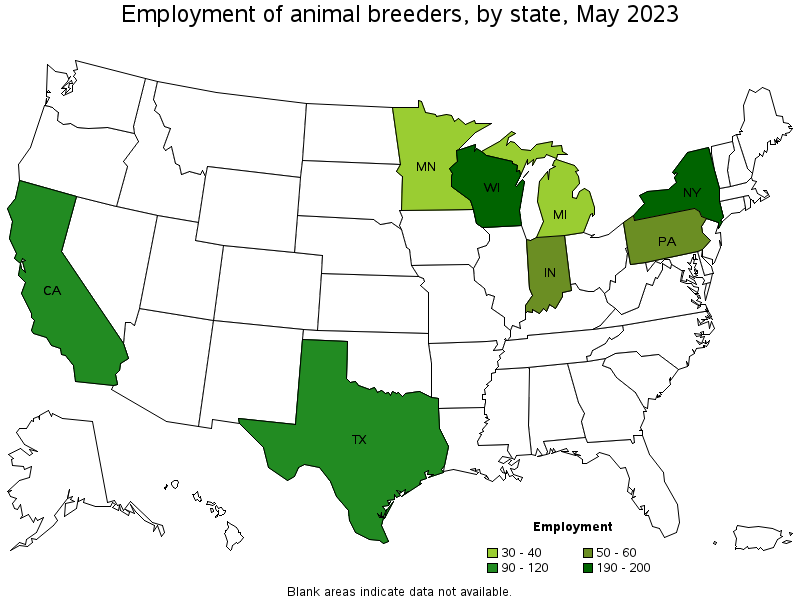
States with the highest employment level in Animal Breeders:
| State | Employment (1) | Employment per thousand jobs | Location quotient (9) | Hourly mean wage | Annual mean wage (2) |
|---|---|---|---|---|---|
| New York | 200 | 0.02 | 2.38 | $ 25.74 | $ 53,540 |
| Wisconsin | 190 | 0.07 | 7.28 | $ 22.45 | $ 46,690 |
| Texas | 120 | 0.01 | 1.00 | $ 24.80 | $ 51,570 |
| California | 90 | 0.01 | 0.58 | $ 24.34 | $ 50,630 |
| Pennsylvania | 60 | 0.01 | 1.13 | $ 29.01 | $ 60,350 |
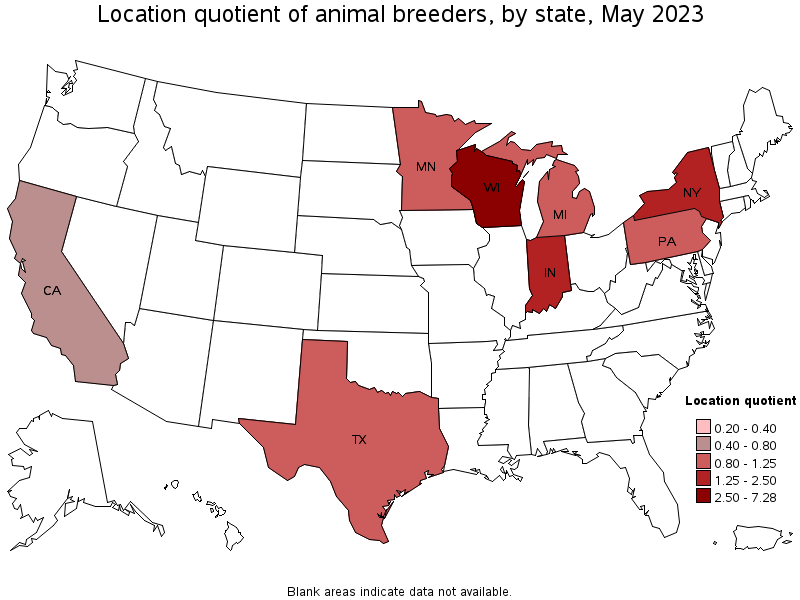
States with the highest concentration of jobs and location quotients in Animal Breeders:
| State | Employment (1) | Employment per thousand jobs | Location quotient (9) | Hourly mean wage | Annual mean wage (2) |
|---|---|---|---|---|---|
| Wisconsin | 190 | 0.07 | 7.28 | $ 22.45 | $ 46,690 |
| New York | 200 | 0.02 | 2.38 | $ 25.74 | $ 53,540 |
| Indiana | 50 | 0.01 | 1.59 | $ 20.02 | $ 41,640 |
| Minnesota | 30 | 0.01 | 1.21 | $ 21.62 | $ 44,970 |
| Pennsylvania | 60 | 0.01 | 1.13 | $ 29.01 | $ 60,350 |
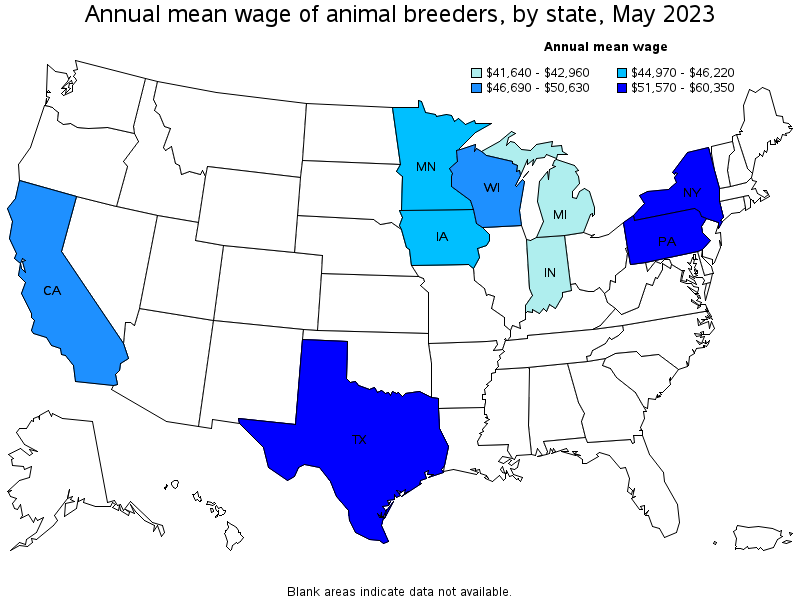
Top paying states for Animal Breeders:
| State | Employment (1) | Employment per thousand jobs | Location quotient (9) | Hourly mean wage | Annual mean wage (2) |
|---|---|---|---|---|---|
| Pennsylvania | 60 | 0.01 | 1.13 | $ 29.01 | $ 60,350 |
| New York | 200 | 0.02 | 2.38 | $ 25.74 | $ 53,540 |
| Texas | 120 | 0.01 | 1.00 | $ 24.80 | $ 51,570 |
| California | 90 | 0.01 | 0.58 | $ 24.34 | $ 50,630 |
| Wisconsin | 190 | 0.07 | 7.28 | $ 22.45 | $ 46,690 |
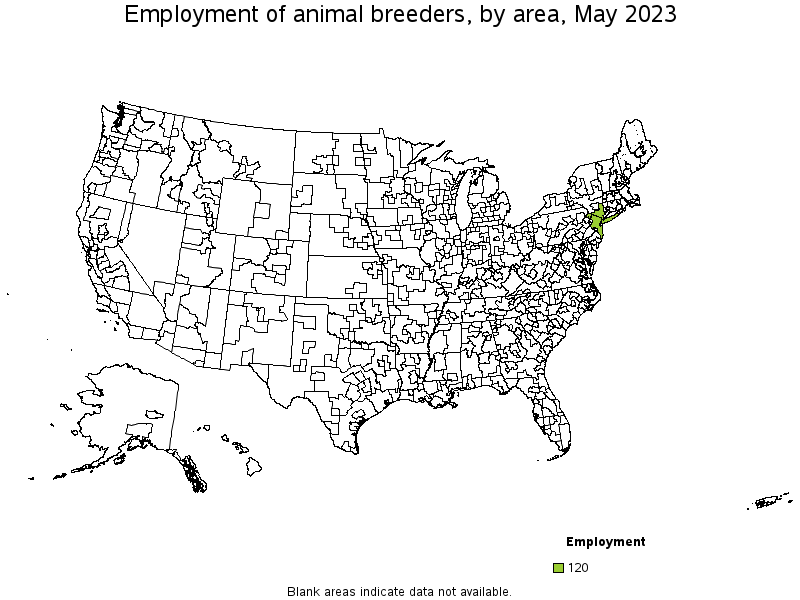
Metropolitan areas with the highest employment level in Animal Breeders:
| Metropolitan area | Employment (1) | Employment per thousand jobs | Location quotient (9) | Hourly mean wage | Annual mean wage (2) |
|---|---|---|---|---|---|
| New York-Newark-Jersey City, NY-NJ-PA | 120 | 0.01 | 1.45 | $ 25.16 | $ 52,320 |
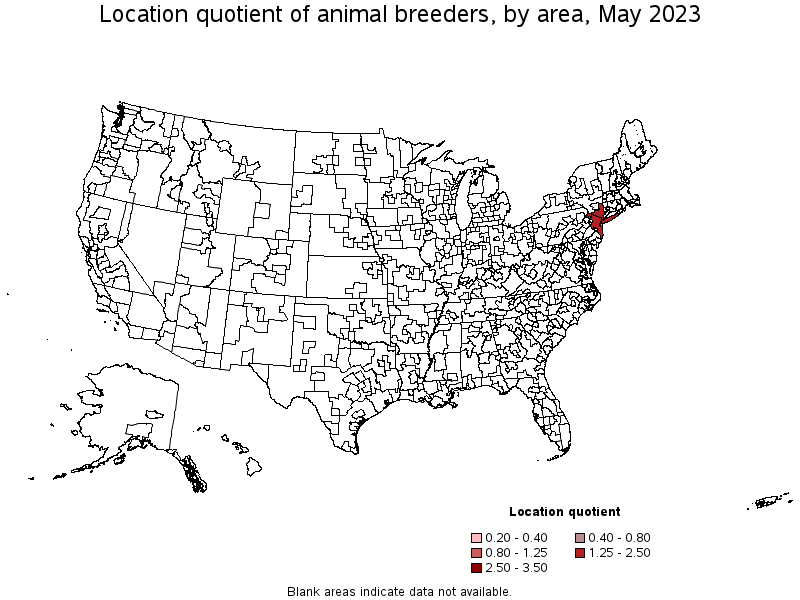
Metropolitan areas with the highest concentration of jobs and location quotients in Animal Breeders:
| Metropolitan area | Employment (1) | Employment per thousand jobs | Location quotient (9) | Hourly mean wage | Annual mean wage (2) |
|---|---|---|---|---|---|
| New York-Newark-Jersey City, NY-NJ-PA | 120 | 0.01 | 1.45 | $ 25.16 | $ 52,320 |
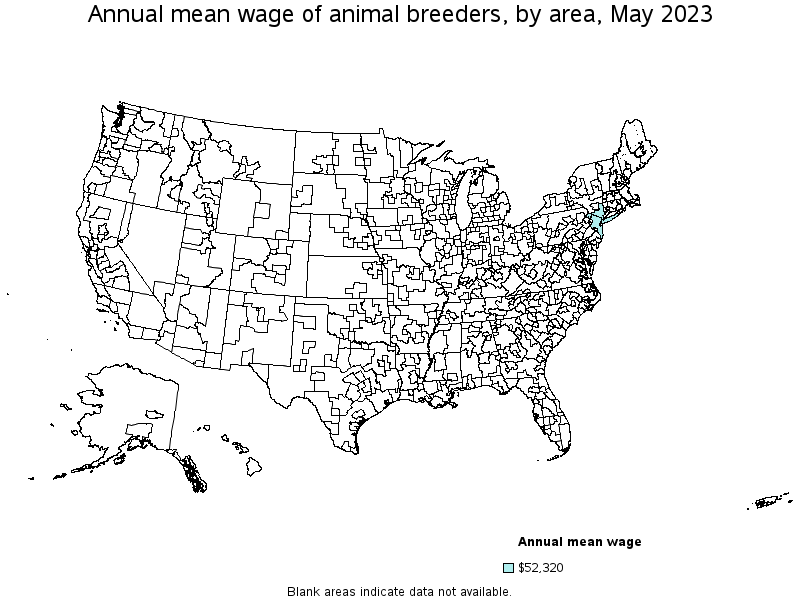
Top paying metropolitan areas for Animal Breeders:
| Metropolitan area | Employment (1) | Employment per thousand jobs | Location quotient (9) | Hourly mean wage | Annual mean wage (2) |
|---|---|---|---|---|---|
| New York-Newark-Jersey City, NY-NJ-PA | 120 | 0.01 | 1.45 | $ 25.16 | $ 52,320 |
These estimates are calculated with data collected from employers in all industry sectors, all metropolitan and nonmetropolitan areas, and all states and the District of Columbia. The top employment and wage figures are provided above. The complete list is available in the downloadable XLS files.
The percentile wage estimate is the value of a wage below which a certain percent of workers fall. The median wage is the 50th percentile wage estimate—50 percent of workers earn less than the median and 50 percent of workers earn more than the median. More about percentile wages.
(1) Estimates for detailed occupations do not sum to the totals because the totals include occupations not shown separately. Estimates do not include self-employed workers.
(2) Annual wages have been calculated by multiplying the hourly mean wage by a "year-round, full-time" hours figure of 2,080 hours; for those occupations where there is not an hourly wage published, the annual wage has been directly calculated from the reported survey data.
(3) The relative standard error (RSE) is a measure of the reliability of a survey statistic. The smaller the relative standard error, the more precise the estimate.
(8) Estimate not released.
(9) The location quotient is the ratio of the area concentration of occupational employment to the national average concentration. A location quotient greater than one indicates the occupation has a higher share of employment than average, and a location quotient less than one indicates the occupation is less prevalent in the area than average.
Other OEWS estimates and related information:
May 2023 National Occupational Employment and Wage Estimates
May 2023 State Occupational Employment and Wage Estimates
May 2023 Metropolitan and Nonmetropolitan Area Occupational Employment and Wage Estimates
May 2023 National Industry-Specific Occupational Employment and Wage Estimates
Last Modified Date: April 3, 2024